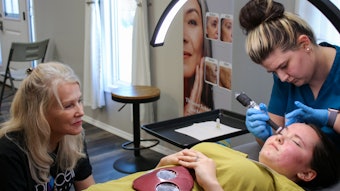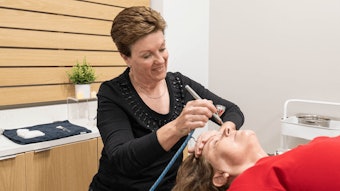
So you have been thinking about making your shop environmentally friendly and more sustainable. Wonderful idea. But, before you read the rest of this article, I need you to do something for me.
I want you to go and count how many individual light bulbs you have in your spa. All of them, right down to the bulb in the exhaust fan in the bathroom. Make a note of what kind of bulb they are too (i.e. regular base, candelabra base, G10, floodlights, tubes, etc.). Now, do a quick Google search to see if there is a “deconstruction crew” in your town. We’ll come back to this in a bit.
You might ask why you should listen to me, who am I to give advice on how to run your business? My name is Eva, and I opened my spa over 20 years ago. I outgrew the first and the second location that I built, and when I found the space that my spa has occupied since 2005, I promised myself that I was going to do things differently. If I can’t find something in nature to use, then I do the research to find the next best thing, which is why the products in my treatment rooms and for sale on my shelves might not be household brand names or found online for sale. But, these products work better than anything else, naturally.
I tell you this because when I built my current spa I followed the same path. I should mention that I arrived in America in 1996 with nothing more than $50 and the clothes on my back and no relatives or family to help me. I had no partners or investors in my business either, so I had to be a little creative when it came to building my dream spa. I found an over 100 year old historic building that had started as one of the original Ford dealerships in the US. This space was 7,000 square feet and had decades of neglect, grease and grime, and I thought to myself that this was going to be my sanctuary of individual rejuvenation, restoration and sustainability. I’m here to share how I did, and you can, incorporate sustainability into your spa space.
Related: Spa Savvy: Top 5 Questions on Sustainability
All of the Lights
Welcome back! I hope that my homework didn’t take you very long. Don’t worry because what I am going to tell you to do with the information you just collected should save you some real money, and in addition to a few other things, it will put you on the path to being one of the most environmentally responsible spas in your town. Let’s start with those lights. Sometime within the next seven days, I want you to go to your nearest in-person store or go online, and buy enough LED lights to replace every single one of your existing bulbs in your spa. I want you to replace ALL of them, even those compact florescent ones. Shop around, and don’t forget to take a look in the clearance aisle.
The average spa has dozens if not hundreds of light bulbs. Think about a six light chandelier with 60 watt bulbs. That one chandelier equals 360 watts. Changing to LED bulbs brings that to six, five watt bulbs, equaling 30 watts total. As you can see, you will notice an immediate and substantial reduction in your electric bill. It saved me literally hundreds of dollars per month. The other neat thing about lights is that you can update to daylight 5,000 bulbs, which if you are doing nails or hair or makeup, provide a more natural light color that clients will really appreciate.
A Base of Sustainability
Turning the old, abandoned dealership into a spa, and a sustainable one no less, was not an easy feat. We had to start from the ground up.
Stud. When it came to my spa, I started with the studs – literally. I made sure that my builders only used metal framing studs instead of traditional wood studs. Why? Steel studs are made from recycled materials. Wood studs, even if they are from sustainable lumber companies, are from trees and require much more energy and effort to go from tree in a forest to stud in my wall. A bonus is that metal studs are also more fireproof than wood studs.
Cement. Next, I found a cement contractor to completely cover 100 years of auto oil, grease and grime with yards and yards of recycled cement. Because recycled cement has more potential deformities, the key to making this work in my space was having the crew add a natural pigment to the cement that made it look like my floors were made of natural marble, with various veins, lines and colors that are found in nature.
Paint. When you are starting with a blank slate, it becomes somewhat easy to find returns and unwanted mis-tints that are perfectly good and will still look beautiful. Not one ounce of paint in my 7,000 sq. ft. spa was made to order. Every ounce was someone else’s mistake that they didn’t want. I made every room a different color.
I also asked a friend to paint murals of my European homeland throughout the entire space.
The result is incredibly unique and visually stunning.
The concept was to build a little village in this giant warehouse of a former auto dealership garage. All of the recycled materials came together to create the perfect palette—think The Venetian without the price tag.
“Sometimes becoming more sustainable can be in the fine details, and sometimes it can be in some big changes.”
Construction Junction
Construction Junction is a big non-profit warehouse that accepts used building materials like old kitchens or surplus doors, windows, tile, etc. They also go to old buildings and salvage hard-to-find, and harder to recreate items like fireplace mantles, church pews, bowling alleys and more. When looking for my spa, I found:
All together, not only did I reduce the need to buy, build and ship new materials to my space, I literally saved several thousand dollars and added incredibly unique personality to my spa.
The Fine Details
Let me tell you, there is a lot more than light bulbs and mis-tint paint that goes into being a truly sustainable spa. Sometimes becoming more sustainable can be in the fine details and sometimes it can be in some big changes.
Eliminating plastic waste. You can eliminate plastic use and waste by using stone crockery. For example, I have a variety of old china mugs and teacups that I use. You can also source what I call “alternative disposables,” which look and feel like plastic, but are actually made from corn or soy oil.
Going digital. You can reduce or eliminate your use of paper by going “digital” with receipts, schedules, brochures, SOAP notes and more.
Insourcing your laundry. You can reduce your negative environmental impact by in-sourcing your laundry. I built a four machine laundry room with recycled washers and dryers into my space. which will eliminate all of the chemicals and other bad byproducts that come with outsourcing this major part of your business. Trust me, I know how much laundry a spa creates, but having in-sourced laundry leads to our environmental impact being much smaller. Just the fact that a linen service truck doesn’t have to be driven to pick up or drop off my towels and sheets is worth the effort.
Incentivizing staff. You can incentivize your staff to help lessen their environmental impact on their way to work by providing them with public transit passes to encourage them to reduce the use of their personal cars and the emissions thereof. Installing an energy star rated refrigerator in your staff area can help encourage employees to bring lunch and snacks from home instead of purchasing fast food or other items that can negatively impact our systems.
Getting customers involved. You can get your customers to buy in to your sustainability by creating a refilling program where customers bring back empty bottles of lotion or shampoo and you can refill them from bulk containers at a discount. This reduces the waste at a very personal local level.
Buying in bulk. Even something as seemingly insignificant as clicking the button on Amazon to group ship items together instead of as they are available can go a long way to reduce the environmental impact you are having – both in your immediate local area and globally.
Find the Right Resources
A mutual friend introduced me to Michael Stusser, which led to me being asked to be one of the 12 Founding Seed Spas of the Green Spa Network, now GSN Planet. GSN Planet is a great resource for adding sustainability practices into your spa. In addition to GSN Planet, there are a wide variety of local, national and global “Green” organizations that you can join, each of which offer different resources. I joined Sustainable Pittsburgh in order to keep up to date with the latest local trends, as well as increasing local awareness to area residents.
One caveat about finding the correct organization to join, as with any popular trend, there are nefarious actors out there happy to take your money and give little in return. Just make sure that joining any group makes financial sense for you. My greater point is that there are an infinite number of things, big and small, daily and long term, that you can do as a spa owner that can really make an impact (or should I say, make less of an impact) on the resources that you are using to successfully operate your business.
One last thing, with the passage of the Inflation Reduction Act, local municipalities will soon receive significant federal funding that they must redirect to local businesses in the form of grants and rebates to reduce their environmental impact and increase sustainability. I urge you to visit your local township office, introduce yourself to the city manager and ask what “Local Climate Action Programs” they have available. I invite you to do what you feel comfortable doing and see where it leads you. And if you need some help, let me know and I’ll do what I can to help because we all have a stake in what may come.











